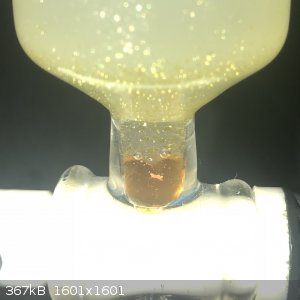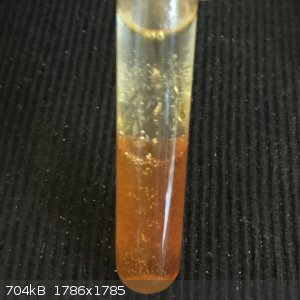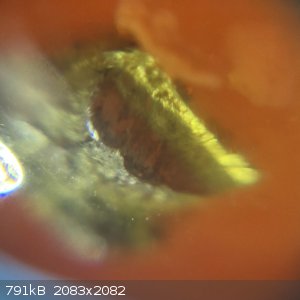LearnedAmateur
National Hazard
   
Posts: 513
Registered: 30-3-2017
Location: Somewhere in the UK
Member Is Offline
Mood: Free Radical
|
|
Synthesis of phenyl-2-ethanol
Materials:
Phenylethylamine HCl,
NaNO2,
H2SO4,
DI H2O
Equipment:
Electronic balance,
100mL beaker
Test tube (optional)
Measuring cylinder
Separatory funnel
Procedure:
This is a modified Sandmeyer reaction, replacing a halide from HX with OH- from H2O, as the reacting species. Very easy to perform and doesn’t
require any special conditions or equipment. This is my first time attempting such a reaction, so it is on a micro scale to avoid any potential
hazards from the diazonium intermediate. This also means that work up on the product is highly inaccurate, but it is proven qualitatively.
1. 0.01mol (1.57 +- 0.005g) of phenylethylamine HCl is dissolved in 20mL water, in a beaker.
2. 0.01mol (0.69 +- 0.005g) NaNO2 is poured into a test tube, and dissolved in 10mL water. Alternatively, the PEA HCl and NaNO2 may be combined in a
single container and 20-30mL water added; there should be no reaction at this stage. The solutions are intimately mixed.
3. 10mL of dilute H2SO4 is prepared. Since the required amount for me was 0.25cm3, I dissolved 1 +- 0.5mL in 9mL water since an excess is preferable.
*Actually, a strong acid is required for the formation of NO+, which is the species that attacks the amine moiety. (H+ + HNO2
<-> H2O + NO+)
4. The acid solution is added slowly, at 2mL per minute. The temperature decrease due to endothermic dissolution of both NaNO2 and PEA HCl means that
active cooling isn’t required.
5. After addition of the acid, the mixture is poured into a sep. funnel and two layers are observed.
Observations:
When acidifying the initial mixture, a white opaqueness forms immediately. This is a colloidal suspension of Ph-2-EtOH which is slightly soluble.
Cooling it down would help improve yield.
Upon stirring, nitrogen gas is evolved for some period of time as a gentle fizz. The only other gas which could be produced is NO2 from the reaction
of the nitrite with acid - lowering the temperature helps prevent this and subsequently increases yield assuming stoichiometric quantities.
Although not as noticeable in the beaker, the alcohol will sink as a separate layer as it is slightly more dense than water. Due to how similar it is
(1.017g/mL), you may find a layer forming on top if no stirring is done.
The alcohol is an orange-yellow colour, I suspect that dissolved NO2 is responsible although there may some inherent colouration. Amount produced is
too small to conduct a workup. At low concentrations, it has a sweet and floral odour. At high concentrations, the smell is reminiscent of white
spirit/naphtha, a general hydrocarbon odour.
Equations:
2 NaNO2 + H2SO4 -> Na2SO4 + 2 HNO2
HNO2 + PhEtNH3+ -> PhEtN2+ + H2O
PhEtN2+ + H2O -> PhEtOH + N2 + H+

Since posting, the amount of alcohol settled in the bottom has approximately doubled, coming up to the bottom of the flare in the funnel. Letting it
sit helps to draw the alcohol out of suspension.
A significant byproduct of this reaction would be phenylethyl-2-nitrite, formed via the reaction of nitrous acid with the alcohol in question.
However, the decreased solubility of the alcohol should limit its formation, and being an unstable ester, I expect that it will eventually decompose
to the alcohol - how long will this take? I’m not sure, I estimate a couple of weeks but with the presence of acid, likely less.
I’m currently in the process of a 5x scale reaction, and have collected a few mL of orange, insoluble liquid. It is still bubbling slightly, the
evolution of gas (N2? NO2?) is clear and not the result of trapped air. There is a layer of water sitting on top which has taken up some of the
alcohol, a clear decrease in volume noted; this will hopefully remove some impurities and thus colour since the first batch was heading in that
direction. Will finish this off and calculate final yield range on Monday, either the crude product or, hopefully, pure-ish.
[Edited on 26-1-2018 by LearnedAmateur]
In chemistry, sometimes the solution is the problem.
It’s been a while, but I’m not dead! Updated 7/1/2020. Shout out to Aga, we got along well.
|
|
|
Cryolite.
Hazard to Others
  
Posts: 269
Registered: 28-6-2016
Location: CA
Member Is Offline
Mood: No Mood
|
|
I suspect what you have here is not very pure. The alkyldiazonium intermediate is very unstable, and I expect carbocation rearrangements or
eliminations to 1-phenethanol, styrene, or various ethylphenols to be a significant side product.
|
|
|
LearnedAmateur
National Hazard
   
Posts: 513
Registered: 30-3-2017
Location: Somewhere in the UK
Member Is Offline
Mood: Free Radical
|
|
I didn’t think so either, from what I’ve managed to find it’s supposed to be a colourless liquid with a rose like odour but instead it is very
petrochemical and quite pungent. I did think there’d be small amounts of styrene and diphenylethyl ether since I used sulphuric acid as opposed to
HCl. Not entirely sure where the colour came from though, if not NO2 (seems to be too intense) then I’d hazard a guess at some sort of azo coupling
product since phenols and anilines are used for this purpose.
I managed to keep the temperature below 40C and only small amounts of acid were present at a time, plus the solutions were all quite dilute as you can
see from my numbers - plenty of water around to react with the diazonium ions before anything else can get in the way. The product(s) are currently
sitting in a loosely stoppered test tube so I’ll see how things change in a few days, also got the ‘paused’ mixture in the sep. funnel (I
conducted the scale-up in there to minimise mechanical loss, quite a bit from the first run stuck to the beaker) so I can compare the two, before and
after a water wash.
In chemistry, sometimes the solution is the problem.
It’s been a while, but I’m not dead! Updated 7/1/2020. Shout out to Aga, we got along well.
|
|
|
Nicodem
Super Moderator
      
Posts: 4230
Registered: 28-12-2004
Member Is Offline
Mood: No Mood
|
|
The nitrosation of phenethylamine in water and the analysis of products formed is described in (on the last page):
180. The decomposition of the nitrites of some primary aliphatic amines
Donald W. Adamson and J. Kenner
J. Chem. Soc., 1934,0, 838-844. DOI: 10.1039/JR9340000838
Phenethyl alcohol is the main product. Some styrene, di(phenethyl)amine, N-nitroso-di(phenethyl)amine and residual phenethylamine were also among the
product. Surprisingly, no hydride shift occurs, as indicated by the absence of 1-phenylethanol (or at least the authors failed to find it among the
product with the methodology and means they had at that time).
Safety note: Nitrosamines are generally genotoxic and carcinogenic.
Attachment: The decomposition of the nitrites of some primary aliphatic amines.pdf (628kB)
This file has been downloaded 421 times
…there is a human touch of the cultist “believer” in every theorist that he must struggle against as being
unworthy of the scientist. Some of the greatest men of science have publicly repudiated a theory which earlier they hotly defended. In this lies their
scientific temper, not in the scientific defense of the theory. - Weston La Barre (Ghost Dance, 1972)
Read the The ScienceMadness Guidelines!
|
|
|
unionised
International Hazard
    
Posts: 5102
Registered: 1-11-2003
Location: UK
Member Is Offline
Mood: No Mood
|
|
N-nitroso-di(phenethyl)amine isn't good news.
|
|
|
LearnedAmateur
National Hazard
   
Posts: 513
Registered: 30-3-2017
Location: Somewhere in the UK
Member Is Offline
Mood: Free Radical
|
|
Good thing I only made tiny amounts then, I didn’t quite realise that nitrosamines were generated via this process and definitely not such a
significant percentage - thanks for the PDF, it’s been quite useful. Shouldn’t be much of a hazard here because they’re large molecules so
shouldn’t be too volatile, and I haven’t been in close contact with the products, only small, hand directed whiffs to ascertain smells.
What reagents would you recommend to destroy the nitrosamine, UV light or H2SO4 should work right? RR’N-NO + H2SO4 <-> RRNH + NOHSO4. Please
excuse me if I’m talking out of my arse, just trying to think of a way to mitigate the hazard with a very limited selection of reagents on hand, and
lacking extensive knowledge on the nitrogen side of organic chem.
[Edited on 28-1-2018 by LearnedAmateur]
In chemistry, sometimes the solution is the problem.
It’s been a while, but I’m not dead! Updated 7/1/2020. Shout out to Aga, we got along well.
|
|
|
zed
International Hazard
    
Posts: 2277
Registered: 6-9-2008
Location: Great State of Jefferson, City of Portland
Member Is Offline
Mood: Semi-repentant Sith Lord
|
|
Similar to the reaction is used on Aminoacids to form halo-acids.
Produces oxides-of-nitrogen. I'll try to find the procedure.
Well, that was fast.
http://orgsyn.org/demo.aspx?prep=cv8p0119
[Edited on 28-1-2018 by zed]
|
|
|
aga
Forum Drunkard
    
Posts: 7030
Registered: 25-3-2014
Member Is Offline
|
|
Good work LearnedAmateur.
Personally i have no idea what you are doing there, yet it is Good to see someone doing an actual experiment.
[Edited on 28-1-2018 by aga]
|
|
|
Cryolite.
Hazard to Others
  
Posts: 269
Registered: 28-6-2016
Location: CA
Member Is Offline
Mood: No Mood
|
|
@zed: the reaction of amino acids with nitrous acid is somewhat different to the reaction with aliphatic amines. The alpha carboxylic acid displaces
the diazonium nitrogen (intramolecular attack, so very fast) to form an unstable 3-membered lactone. This is then attacked by halide ion in solvent to
break the ring and form the haloacid product. Note that the reaction in the reference proceeds with retention of configuration-- the two Sn2 attacks
effectively reverse the stereochemistry twice.
@LA: maybe try adding a reducing agent like metabisulfite or zinc dust? This should help sequester the released nitrosonium cation.
|
|
|
LearnedAmateur
National Hazard
   
Posts: 513
Registered: 30-3-2017
Location: Somewhere in the UK
Member Is Offline
Mood: Free Radical
|
|
@zed It’s quite a versatile reaction; minus the nitrosamine risk, I’m surprised that Sandmeyer reactions aren’t more popular around here since
there are a good deal of susbstituents from somewhat common reagents, and the most difficult part is getting your hands on the actual amine itself.
@aga I just wanted to branch out and try something new, when I’m messing around with organics it tends to focus around the carbon- oxygen bond. Got
plenty of PEA and sodium nitrite, so that was the obvious one to try out, in fact I think it’s the only primary amine I have access to.. But yeah, I
figured I’d actually write this one up, always good info for when you want to return to a particular reaction.
@Cryolite Zinc, now that’s something I do have a small amount of. Will see what happens when some is added to the crude product, if I understand
correctly then it should give off nitrogen gas and leave an amine, right?
In chemistry, sometimes the solution is the problem.
It’s been a while, but I’m not dead! Updated 7/1/2020. Shout out to Aga, we got along well.
|
|
|
Cryolite.
Hazard to Others
  
Posts: 269
Registered: 28-6-2016
Location: CA
Member Is Offline
Mood: No Mood
|
|
I would expect reducing a nitrosamine to give the corresponding hydrazine in alkaline solutions and the amine in acid solutions. Either one should be
good enough-- both diphenethylamine and 1,1-diphenethylhydrazine are soluble in hydrochloric acid while the desired product is not. From the paper
Nicodem posted, this means the only significant products left are phenethyl alcohol and styrene which can be separated by distillation.
|
|
|
LearnedAmateur
National Hazard
   
Posts: 513
Registered: 30-3-2017
Location: Somewhere in the UK
Member Is Offline
Mood: Free Radical
|
|
Alright, thanks, the amine route was the one I was hoping to be able to take, the only issue I have is pushing the remaining alcohol out of solution
so I’ll try saturate the aqueous phase with NaCl once i manage to do the reduction.
In chemistry, sometimes the solution is the problem.
It’s been a while, but I’m not dead! Updated 7/1/2020. Shout out to Aga, we got along well.
|
|
|
LearnedAmateur
National Hazard
   
Posts: 513
Registered: 30-3-2017
Location: Somewhere in the UK
Member Is Offline
Mood: Free Radical
|
|
Okay, just dropped in a small lump of zinc metal, filing it into a powder would’ve been too time consuming. Bubbles are being generated and the zinc
has taken on a greenish tinge, just have to wait until the former has stopped then the amines can be extracted out.
 
In chemistry, sometimes the solution is the problem.
It’s been a while, but I’m not dead! Updated 7/1/2020. Shout out to Aga, we got along well.
|
|
|
zed
International Hazard
    
Posts: 2277
Registered: 6-9-2008
Location: Great State of Jefferson, City of Portland
Member Is Offline
Mood: Semi-repentant Sith Lord
|
|
Riddle me this, Cryolite. My reaction mechanisms, and stereochemistry, are largely misremembered.
We have converted the L-Amino Acid to the L-Haloacid.
If we now react the L-Haloacid with an amine or ammonium salt, will we end up with the D-Aminoacid?
If so. This would allow us to create Aminoacids, that are expensive and not easy to come by.
|
|
|
Loptr
International Hazard
    
Posts: 1347
Registered: 20-5-2014
Location: USA
Member Is Offline
Mood: Grateful
|
|
I seem to recall there being several factors around this, but in general if the reaction takes the SN2 pathway, you will end up with inversion because
of the concerted backside attack. If it follows SN1, then you will end up with a mixture of retention and inversion, due to it proceeding stepwise
with the leaving group being lost, followed by formation of a carbocation, and then attack by the nucleophile.
Now, and this is where my memory gets even murkier, the R- and S- designations won't necessarily change even if inversion occurs. In order for this to
happen, the leaving group and nucleophile must have the same CIP priority relative to the other substituents.
[Edited on 31-1-2018 by Loptr]
"Question everything generally thought to be obvious." - Dieter Rams
|
|
|
Cryolite.
Hazard to Others
  
Posts: 269
Registered: 28-6-2016
Location: CA
Member Is Offline
Mood: No Mood
|
|
@zed: Yes, that reaction will indeed give D-amino acids. See https://www.google.com/patents/US4962231 for example.
Relevant passage:
EXAMPLE 1
10.2 g (0.094 mole) of L-chloropropionic acid (96percent ee) was stirred together with 150 g (2.2 moles) of 25percent strength NH3 solution for 5
hours at 70° C. in an autoclave. The discharged mixture was brought to pH 6.1 with concentrated HCl and salts were removed by electrodialysis.
Subsequent crystallization by evaporating down the aqueous solution gave 5.8 g (0.065 mole) of pure D-alanine (70percent yield, ee >98percent).
Akabori anyone? 
|
|
|
zed
International Hazard
    
Posts: 2277
Registered: 6-9-2008
Location: Great State of Jefferson, City of Portland
Member Is Offline
Mood: Semi-repentant Sith Lord
|
|
Nice. Thank you.
|
|
|